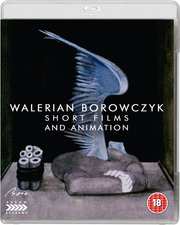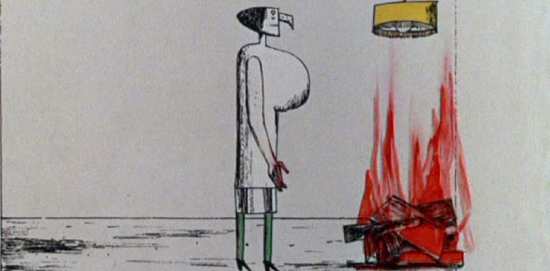Review for Walerian Borowczyk Short Films and Animation
For the first decade of his highly varied and controversial career, Walerian Borowczyk exclusively made short films, initially in his native Poland, but then mostly in France, where he settled permanently in the late 1950s. This release from Arrow, part of a wider set of Borowczyk releases, includes the vast majority of the shorts that he made between 1959 and 1984, apart from ones that were originally intended to accompany specific features.
It’s inevitably a mixed-bag as Borowczyk changes approach, style and subject matter so frequently that it’s difficult to see the joins sometimes. But a wealth of material is included here and for the curious, like me, it’s great fun to watch the varying results.
The series of films is introduced by Terry Gilliam who has clearly been much influenced by early Borowczyk. In fact there are sequences here (like in Astronauts for example) that look like pure Gilliam.
Like any compilation there are highlights and lowlights, and this package is no exception, though which is which may vary depending on taste.
For me, the spookily reversed ‘Renaissance’, which takes a scene of utter carnage and reverses it in a most inventive way to bring it back to order, is perhaps the most visually striking and thought-provoking though the full length surrealist feature, Mr. and Mrs. Kabal was also very striking.
The whole package comes with brand new digital transfers (which are variable depending on source material available of course) and English subtitles where necessary.
Here are some of the highlights of the set in more detail:
Mr & Mrs Kabal’s Theatre
In 1967, Borowczyk made his feature debut, a grotesque and surreal fantasy about the physically and temperamentally mismatched couple Mr & Mrs Kabal. Made with a tiny production team at a time when animated feature films were far scarcer than they are now, it’s almost the polar opposite of a Disney film, with angular, mainly monochrome graphics bringing the Kabals’ universe to life. It trots along at a strangely dream-like pace every now and then cutting to live footage of bikin-clad girls being molested by a white bearded old man. At the start and end of the piece we see Bowrowczyk himself appear as a kind of cut out animation introducing and concluding the piece.
It appears to be about a strange couple, Mrs Kabal, an iron mechanical monster with a hooked nose a large chest and skinny, almost dangling legs, primitively drawn in sketchy pen strokes. When she becomes indigested after swallowing a butterfly, her husband appears to travel to her insides to relieve the problem. Or something like that. Almost as fascinating as the surreal and abstract animation are the incredible sound effects, apparently created by Boroczyk himself by using self-made wooden ‘instruments’.
Astronauts (1959)
This piece was co-created by Boroczyk with Chris Marker and is akin to a set Python-ere piece by Terry Gilliam set to a soundtrack often reminiscent of Roberta Leigh’s ‘Space Patrol’ which is os a similar vintage. It combines cut out photography and illustrations in a moving montage featuring an owl. Very surreal.
The Concert (1962)
This is a very simplistic, almost child-like animation, mainly in black and white but with hints of colouring. There is some minimal dialogue but lots of music. A lady with a hooked nose makes an appearance, probably the first incarnation of Mrs. Kabal who would be seen in a feature length animation a few years later. It had a kind of 1970’s children’s TV vibe to it though I suspect you’d struggle to get a child to sit through it today.
Grandmother’s Encyclopaedia (1963)
This is another Gilliam-like animation using montage – perhaps the closest example in the collection. Very Monty Python and very short.
Renaissance (1963), Angels’ Games (1964)
Perhaps the most impressive film in the set, this stop-frame piece takes a scene of what appears to be utter carnage and plays it backwards in time piece by piece until we see a neat arrangement of a doll resting on a table with one or two other significant ornaments and books around. We see paper peeling itself back on to the walls and pages of books unrolling themselves and placing themselves neatly back in to the books. A doll with a cracked head reconstructs itself and sits neatly on the table. The audio throughout is significant, really bringing home each and every bit of movement.
Joachim’s Dictionary (1965)
Another very primitive line drawn animation with orchestral effects and occasional additions of colour, going through a series of words illustrated by animations. One sequence, for example, features a man touching childishly drawn breasts and blushing as a consequence. Bizarre!
Rosalie (1966)
Using a long single tracking shot along along with dialogue this simple sequence tells the story of a lady who has killed her own child. All the artifacts are lined up as if in a courtroom and eventually the camera ends on the mother Rosalie who breaks down in tears. Arguably the first of his live action narratives although the fact that it’s actually stop-frame and the careful arrangement of all the items mean it probably sits more usefully in this set.
Diptych (1967)
Borowczyk presents two, seemingly distinct ‘volets’. In the first, we see an old farmer and his dog shot in stark black and white. The second features a succession of tableaux vivant in startling colour featuring houseplants and kittens. It all comes across a bit like the lid of a chocolate tin.
Gavotte (1967)
Two bored dwarves in a Victorian house fight over a cushion. Like Diptych, Gavotte constitutes a further step in the direction of live action film making. Completely wordless, Borowczyk takes his dramatic cue from a gavotte by Jean-Philippe Rameau, played on a harpsichord off camera. A very singular piece it shows how Boroczyk is not really interested in changing the perspective of the camera but far more interested in the theatre of the piece with the dwarves and other characters walking into and out of shot.
The Phonograph (1969)
This one is like Bagpuss on acid. It uses loads of stop-frame of wind up musical cylinders and other machines with a scratchy melancholic soundtrack. Theer are lots of close ups of wood textures and cuts to photos too. It seemed to be attempting to capture lost time in some way. Very enjoyable.
Scherzo Infernal (1984)
This is a very short primitive animation featuring some fairly obtuse red nipples amongst other things. Very short and very surreal!
EXTRA FEATURES
Introduction by filmmaker and animator Terry Gilliam – clearly a huge fan and obviously greatly influenced by Boroczyk, Gilliam has spearheaded an online fund-raising campaign to clean up and re-issue these early works. This is brief but positively infectious in its enthusiasm.
Film is Not a Sausage - a 30 minute documentary about Borowczyk’s animated work featuring Borowczyk, producer Dominique Duvergé-Ségrétin, assistant André Heinrich and composer Bernard Parmegiani. Quite detailed and lots of great background here.
Blow Ups - a 5 minute ‘visual essay’ by Daniel Bird about Borowczyk’s works on paper which supports the theory that he is a painter / sculptor who sees film-making as an extension of his art.
Commercials by Walerian Borowczyk: Holy Smoke (1963), The Museum (1964), Tom Thumb (1966)
Reversible sleeve featuring original poster designs – I haven’t seen this so can’t comment though I do like Arrow’s reversible artwork initiative. It means you can decide which presentation you prefer,
Collector’s booklet – I didn't receive one specifically for this disc but was lucky enough to be sent a PDF of the magnificent 250 page book which comes as part of the limited edition box set (now sold out sadly). If the booklet is anything like that one it won’t disappoint.
If abstract art-films and primitive montage stop-frame animation is of interest to you, or if you’re a Boroczyk fan and want to dig back further to see what makes him tick, then this set may be for you. If neither applies then I would avoid. If it does appeal then you’re going to love this feature packed collection without a doubt.



































Your Opinions and Comments
Be the first to post a comment!